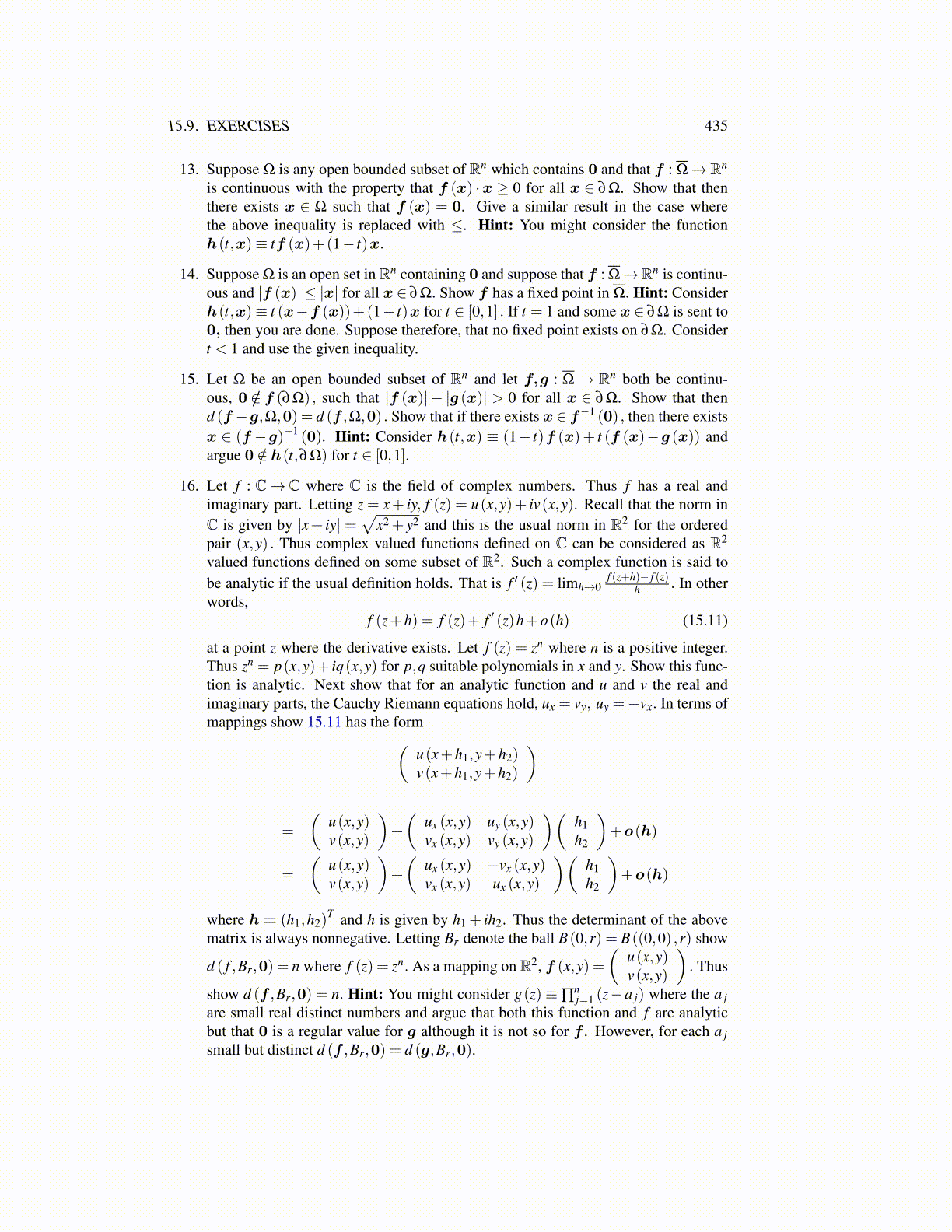
15.9. EXERCISES 435
13. Suppose Ω is any open bounded subset of Rn which contains 0 and that f : Ω→ Rn
is continuous with the property that f (x) ·x ≥ 0 for all x ∈ ∂Ω. Show that thenthere exists x ∈ Ω such that f (x) = 0. Give a similar result in the case wherethe above inequality is replaced with ≤. Hint: You might consider the functionh(t,x)≡ tf (x)+(1− t)x.
14. Suppose Ω is an open set in Rn containing 0 and suppose that f : Ω→Rn is continu-ous and |f (x)| ≤ |x| for all x ∈ ∂Ω. Show f has a fixed point in Ω. Hint: Considerh(t,x)≡ t (x−f (x))+(1− t)x for t ∈ [0,1] . If t = 1 and some x ∈ ∂Ω is sent to0, then you are done. Suppose therefore, that no fixed point exists on ∂Ω. Considert < 1 and use the given inequality.
15. Let Ω be an open bounded subset of Rn and let f,g : Ω→ Rn both be continu-ous, 0 /∈ f (∂Ω) , such that |f (x)| − |g (x)| > 0 for all x ∈ ∂Ω. Show that thend (f −g,Ω,0) = d (f ,Ω,0) . Show that if there exists x ∈ f−1 (0) , then there existsx ∈ (f −g)−1 (0). Hint: Consider h(t,x) ≡ (1− t)f (x)+ t (f (x)−g (x)) andargue 0 /∈ h(t,∂Ω) for t ∈ [0,1].
16. Let f : C→ C where C is the field of complex numbers. Thus f has a real andimaginary part. Letting z = x+ iy, f (z) = u(x,y)+ iv(x,y). Recall that the norm inC is given by |x+ iy| =
√x2 + y2 and this is the usual norm in R2 for the ordered
pair (x,y) . Thus complex valued functions defined on C can be considered as R2
valued functions defined on some subset of R2. Such a complex function is said tobe analytic if the usual definition holds. That is f ′ (z) = limh→0
f (z+h)− f (z)h . In other
words,f (z+h) = f (z)+ f ′ (z)h+o(h) (15.11)
at a point z where the derivative exists. Let f (z) = zn where n is a positive integer.Thus zn = p(x,y)+ iq(x,y) for p,q suitable polynomials in x and y. Show this func-tion is analytic. Next show that for an analytic function and u and v the real andimaginary parts, the Cauchy Riemann equations hold, ux = vy, uy =−vx. In terms ofmappings show 15.11 has the form(
u(x+h1,y+h2)v(x+h1,y+h2)
)
=
(u(x,y)v(x,y)
)+
(ux (x,y) uy (x,y)vx (x,y) vy (x,y)
)(h1h2
)+o(h)
=
(u(x,y)v(x,y)
)+
(ux (x,y) −vx (x,y)vx (x,y) ux (x,y)
)(h1h2
)+o(h)
where h= (h1,h2)T and h is given by h1 + ih2. Thus the determinant of the above
matrix is always nonnegative. Letting Br denote the ball B(0,r) = B((0,0) ,r) show
d ( f ,Br,0) = n where f (z) = zn. As a mapping on R2, f (x,y) =(
u(x,y)v(x,y)
). Thus
show d (f ,Br,0) = n. Hint: You might consider g(z) ≡∏nj=1 (z−a j) where the a j
are small real distinct numbers and argue that both this function and f are analyticbut that 0 is a regular value for g although it is not so for f . However, for each a jsmall but distinct d (f ,Br,0) = d (g,Br,0).